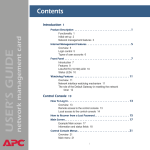Download APC Network Management Card AP9618 User`s guide
Transcript
Network Management Card AP9617 AP9618 AP9619 Installation and Quick Start This manual is available in English on the enclosed CD. ❖❖❖ Dieses Handbuch ist in Deutsch auf der beiliegenden CD-ROM verfügbar. ❖❖❖ Este manual está disponible en español en el CD-ROM adjunto. ❖❖❖ Ce manuel est disponible en français sur le CD-ROM ci-inclus. ❖❖❖ Questo manuale è disponibile in italiano nel CD-ROM allegato. ❖❖❖ Contents How to Avoid Equipment Damage . . . . . . . . . . . . . . 1 Disconnect UPS power 1 Disconnect chassis power 1 How to Recover from a Lost Password. . . . . . . . . . . . 2 Preliminary Information . . . . . . . . . . . . . . . . . . . . . . 3 New standard features 3 Existing features 3 AP9618 features 3 AP9619 features 3 AP9618U and AP9619U upgrade kits 4 Integrated Environmental Monitor feature (AP9618 and AP9619) 4 Internal analog modem feature (AP9618) 4 Related documents 4 Inventory 5 Receiving and inspection 5 Please Recycle 5 Installation in a UPS . . . . . . . . . . . . . . . . . . . . . . . . . 6 Overview 6 Step 1: Turn off all power (Smart-UPS or MatrixUPS) 6 Step 2: Install the Network Management Card 7 Expansion/Triple Chassis Installation . . . . . . . . . . . . . 8 Overview 8 When to use the AC adapter (AP9505) 8 Step 1: Disconnect the chassis from all power 8 Step 2: Install the Network Management Card 9 Installation and Quick Start i Contents Quick Configuration . . . . . . . . . . . . . . . . . . . . . . . . 10 Overview 10 TCP/IP configuration methods 10 APC Management Card Wizard 11 BOOTP & DHCP configuration 11 Local access to the control console 14 Remote access to the control console 15 Control console 16 How to Access a Configured Network Management Card . . . . . . . . . . . . . . . . . . . . . . . . . . . . . . . . . . . 17 Overview 17 Web interface 17 Telnet 17 SNMP 17 FTP 18 APC Management Card Wizard 18 Analog modem (AP9618) 18 ii Installation and Quick Start How to Avoid Equipment Damage Disconnect UPS power You do not need to turn off a Symmetra® or a Silcon® model UPS to install the Management Card. Caution Damage to the UPS or APC Network Management Card (AP9617 or AP9618) can result if you do not remove all AC and DC power from a Smart-UPS® or Matrix-UPS®, an Expansion Chassis, or a Triple Expansion Chassis before you install the Management Card. Smart-UPS 1. Turn off the equipment that connects to the UPS. 2. Disconnect the UPS from its AC input source. 3. Press the OFF button on the UPS for approximately five seconds to turn off the DC (battery) power. Test Matrix-UPS 1. Turn off the equipment that connects to the UPS. 2. Turn off the circuit breaker on the rear panel of the UPS. Disconnect chassis power Make sure that any Expansion Chassis or Triple Expansion Chassis is disconnected from all power: disconnect the chassis cable from the UPS and, if the AC-to-DC Adapter (AP9505) option is used, disconnect the adapter from the chassis. Installation and Quick Start 1 How to Recover from a Lost Password You can use a local computer that connects to the Management Card or other device through the serial port to access the control console. 1. Select a serial port at the local computer, and disable any service that uses that port. 2. Connect the serial cable (940-0103) to the selected port on the computer and to the configuration port at the battery manager. 3. Run a terminal program (such as HyperTerminal®) and configure the selected port as follows: – 9600 bps – 8 data bits – no parity – 1 stop bit – no flow control. 4. Press ENTER, repeatedly if necessary, to display the User Name prompt. If you are unable to display the User Name prompt, verify the following: – The serial port is not in use by another application. – The terminal settings are correct as specified in step 3. – The correct cable is being used as specified in step 2. 5. Press the Reset button. The Status LED will flash alternately orange and green. Press the Reset button a second time immediately while the LED is flashing to reset the user name and password to their defaults temporarily. 6. Press ENTER as many times as necessary to redisplay the User Name prompt, then use the default, apc, for the user name and password. (If you take longer than 30 seconds to log on after the User Name prompt is redisplayed, you must repeat step 5 and log on again.) 7. From the Control Console menu, select System, then User Manager. 8. Select Administrator, and change the User Name and Password settings, both of which are now defined as apc. 9. Press CTRL-C, log off, reconnect any serial cable you disconnected, and restart any service you disabled. 2 Installation and Quick Start Preliminary Information Features All Network Management Cards have standard features that do the following: • Detect 10/100 Mbps connection speeds • Provide a data log accessible by FTP or a Web browser • Provide UPS scheduling features • Provide support for the APC PowerChute Network Shutdown utility • Provide an event log that is accessible by Telnet, FTP, SCP, or a Web browser • Generate system log (Syslog) messages • Allow using a dynamic host configuration protocol (DHCP) server to provide the TCP/IP values a Network Management Card needs for network communication • Generate e-mail notifications for UPS or system events • Limit SNMP traps and e-mail notifications based on the severity level of the events • Allow you to configure multiple Management Cards simultaneously over the network • Provide support for APC Silcon UPS models • Provide UPS-specific application modules based on the Management Card’s hardware platform • Provide enhanced security AP9618 features The AP9618 Network Management Card EM/MDM includes the analog modem and Integrated Environmental Monitor features described on “Integrated Environmental Monitor feature (AP9618 and AP9619)” on page 4. AP9619 features The AP9619 Network Management Card EM includes the Integrated Environmental Monitor features described on “Integrated Environmental Monitor feature (AP9618 and AP9619)” on page 4; the AP9619 does not include the analog modem feature. Installation and Quick Start 3 Preliminary Information AP9618U and AP9619U upgrade kits You can use an AP9618U kit to convert an AP9617 Network Management Card EX or an AP9619 Network Management Card EM into an AP9618 Network Management Card EM/ MDM. You can use an AP9619U kit to convert an AP9617 Network Management Card EX into an AP9619 Network Management Card EM. Integrated Environmental Monitor feature (AP9618 and AP9619) The AP9618 and AP9619 Management Cards include an Integrated Environmental Monitor that provides the following features: • A temperature/humidly probe • Two input contacts • Two-position output relay In addition to the Integrated Environmental Monitor, an AP9618 or AP9619 Management Card can still monitor and manage an external Environmental Monitoring Unit or Environmental Monitoring Card. Internal analog modem feature (AP9618) An AP9618 Network Management Card EM/MDM has an internal analog modem that provides for the following out-ofband communication: • Dial-out notifications for APCs Remote Monitoring Service (RMS) • Dial-in access to the Management Card’s Console Interface Related documents The APC Network Management Card utility CD contains the following documentation: • Network Management Card User’s Guide (.\doc\usrguide.pdf) • PowerNet® Management Information Base (MIB) Reference Guide (.\doc\mibguide.pdf) • Network Management Card Release Notes (.\relnotes.txt) • Installation instructions in text format (.\install.txt) 4 Installation and Quick Start Preliminary Information Inventory The Management Card package includes the following items: • This Installation and Quick Start Guide • Network Management Card • APC Network Management Card utility CD • Smart-signaling cable • Installation of Multiple Management Cards sheet • Declaration of Conformity • Warranty registration form • Network Management Card quality assurance test slip Note Disclaimer American Power Conversion is not responsible for damage sustained during reshipment of this product. Caution Please recycle Save the assurance test slip. The slip contains the MAC address that you may need when performing the procedures outlined in “Quick Configuration” on page 10. The Network Management Card is sensitive to static electricity. When handling the Management Card, touch only the end plate while using one or more of these electrostaticdischarge devices (ESDs): wrist straps, heel straps, toe straps, or conductive shoes. The shipping materials are recyclable. Please save them for later use, or dispose of them appropriately. APC management products, including the Network Management Card, contain removable, lithium coin-cell batteries. When discarding these batteries, you must follow local rules for recycling. Installation and Quick Start 5 Installation in a UPS Overview You can install the Management Card in a card slot in a Smart-UPS, Matrix-UPS, or Symmetra. For a Silcon UPS, the Management Card installs in a Silcon Triple Expansion Chassis (AP9604S). Step 1: Turn off all power (Smart-UPS or Matrix-UPS) You do not need to turn power off for a Symmetra UPS. Caution Damage to the UPS or Management Card can result if you do not remove all AC and DC power from a Smart-UPS or Matrix-UPS model UPS. Smart-UPS 1. Turn off the equipment that connects to the UPS. 2. Disconnect the UPS from its AC input source. 3. Press the OFF button on the UPS for approximately five seconds to turn off the DC (battery) power. Matrix-UPS 1. Turn off the equipment that connects to the UPS. 2. Turn off the circuit breaker on the rear panel of the UPS. 6 Installation and Quick Start Test Installation in a UPS Step 2: Install the Network Management Card If you are installing the Management Card in a Symmetra UPS that uses more than one APC management product, see Installation of Multiple Management Cards, a copy of which came with the Management Card. You must install the APC management products in the correct order for them to operate properly. Caution The Network Management Card is sensitive to static electricity. When handling the Management Card, touch only the end plate while using one or more of these electrostaticdischarge devices (ESDs): wrist straps, heel straps, toe straps, or conductive shoes. 1. Use the same screws that hold the slot cover in place to secure the Management Card in the UPS card slot. 2. Connect a network interface cable to the 10/100Base-T network connector on the Management Card. 3. Reconnect the UPS to its input power source. 4. Turn on the UPS. 5. See “Quick Configuration” on page 10. Installation and Quick Start 7 Expansion/Triple Chassis Installation Overview Use an Expansion Chassis or a Triple Expansion Chassis if the UPS has no card slot available. Use only a Silcon Triple Expansion Chassis (AP9604S) with a Silcon UPS. Note The Management Card installs in the chassis and communicates with the UPS through the cable connection between the chassis and the UPS. When to use the AC adapter (AP9505) Use the optional AC adapter with a chassis under the following circumstances: • To connect the chassis to an independent AC input so that the Management Card can continue to operate if the UPS is turned off or fails. • To provide the APC management products mounted in a Triple Expansion Chassis with more current than the UPS can provide through the UPS-to-chassis cable. – A Silcon UPS provides up to 500 mA. – A Matrix-UPS, Smart-UPS, or Symmetra-UPS provide up to 200 mA. For information about the current requirements for APC management products, do the following: a. Go to APC’s Support page (www.apc.com/support). b. Click the Knowledge Base link in the “Search the Knowledge Base” section. c. Use “current draw” as your search phrase. d. Select the “Recommended connection order and power requirements for APC SmartSlot accessories” document. Step 1: Disconnect the chassis from all power Make sure that the chassis is disconnected from any power source: Disconnect the chassis cable from the UPS and, if the UPS uses an AC adapter, disconnect that adapter from the chassis. 8 Installation and Quick Start Expansion/Triple Chassis Installation Step 2: Install the Network Management Card If the UPS uses more than one APC management product, see Installation of Multiple Management Cards, a copy of which came with the Management Card. You must install the APC management products in the correct order for them to operate properly. The Network Management Card is sensitive to static electricity. When handling the Management Card, touch only the end plate while using one or Caution more of these electrostatic-discharge devices (ESDs): wrist straps, heel straps, toe straps, or conductive shoes. 1. If a cable is connected to the serial port at the UPS or chassis, stop the APC service that uses that serial connection and disconnect the cable. 2. If you are installing a chassis, connect the chassis to the UPS serial port. 3. Use the same screws that hold the expansion slot cover in place to secure the Management Card in the chassis slot. 4. Connect a network interface cable to the Management Card’s 10/100Base-T network connector. 5. If you are using the AC Adapter (AP9505): a. Connect the adapter to the chassis. b. Connect the adapter to an independent AC input so that the Management Card can continue to operate if the UPS is turned off or fails. 6. If you disconnected a cable in step 1, reconnect that cable to the serial port at the chassis, and restart the associated APC service. 7. See “Quick Configuration” on page 10. Installation and Quick Start 9 Quick Configuration Overview You must configure the following TCP/IP settings before the APC Network Management Card can operate on a network: • IP address of the Management Card • Subnet mask • Default gateway If a default gateway is unavailable, use the IP address of a computer that is located on the same subnet as the Management Card and that is usually running. The Management Card uses Note the default gateway to test the network when traffic is very light. See also See “Watchdog Features” in the “Introduction” of the APC Network Management Card User’s Guide for more information about the watchdog role of the default gateway. TCP/IP configuration methods Use one of the following methods to define the TCP/IP settings needed by the Management Card: • APC Management Card Wizard (See “APC Management Card Wizard” on page 11 if it is supported for the firmware release you are using.) • BOOTP or DHCP server (See “BOOTP & DHCP configuration” on page 12.) • Local computer (See “Local access to the control console” on page 15.) • Networked computer (See “Remote access to the control console” on page 15.) 10 Installation and Quick Start Quick Configuration APC Management Card Wizard You can use the APC Management Card Wizard (if it is supported for the firmware release you are using) at a Windows® 98, Windows NT® 4.0, Windows 2000, or Windows XP computer to configure a Management Card. Not all releases support the wizard. To configure multiple Management Cards, or to configure a Management Card, see the Network Management Card User’s Guide on the Utility See also CD. 1. Insert the APC Network Management Card utility CD into a computer on your network. 2. Launch the Management Card Wizard, when prompted, or, if prompted to restart the computer, access the Wizard from the Start menu after the computer has restarted. 3. Wait for the Wizard to discover the unconfigured Management Card, then follow the on-screen instructions. Note If you leave the Start a Web browser when finished option enabled, you can use apc for both the user name and password to access the Management Card through your browser. Installation and Quick Start 11 Quick Configuration BOOTP & DHCP configuration The Boot Mode setting, a TCP/IP option in the Management Card’s Network menu, identifies how the TCP/IP settings will be defined. The possible settings are Manual, DHCP only, BOOTP only, and DHCP & BOOTP (the default setting).The DHCP & BOOTP setting assumes that a properly configured DHCP or BOOTP server is available to provide TCP/IP settings to Management Cards. If these servers are unavailable, see “APC Management Card Wizard” on this page, “Local access to the control console” on page 15, or “Remote access to the control console” on page 15 to configure the needed TCP/IP settings. With Boot Mode set to DHCP & BOOTP, the Management Card attempts to discover a properly configured server. It first searches for a BOOTP server, then a DHCP server, and repeats this pattern until it discovers a BOOTP or DHCP server. For more information, see “BOOTP” on page 12 or “DHCP” on page 14. BOOTP. You can use an RFC951-compliant BOOTP server to configure the TCP/IP settings for the Management Card. Note The BOOTP only setting assumes that a properly configured BOOTP server is available to provide TCP/IP settings to APC Network Management Cards. If a BOOTP server is unavailable, see “APC Management Card Wizard” on page 11, “Local access to the control console” on page 15, or “Remote access to the control console” on page 15 to configure the TCP/IP settings. 1. Make sure that the BOOTP only setting, a TCP/IP option in the Management Card’s Network menu, is enabled 2. Enter the Management Card’s MAC and IP addresses, the subnet mask and default gateway settings, and an optional bootup file name in the BOOTPTAB file of the BOOTP server. 12 Installation and Quick Start Quick Configuration Note For the MAC address, look on the bottom of the Management Card or on the Quality Assurance slip included in the package. 3. When the Management Card reboots, the BOOTP server provides it with the TCP/IP settings. – If you specified a bootup file name, the Management Card attempts to transfer that file from the BOOTP server using TFTP or FTP. The Management Card assumes all settings specified in the bootup file. – If you did not specify a bootup file name, the Management Card can be configured remotely by using the control console or the Web interface: user name and password are both apc, by default. To create a bootup file, see your BOOTP server documentation. See also Installation and Quick Start 13 Quick Configuration DHCP. You can use a RFC2131/RFC2132-compliant DHCP server to configure the TCP/IP settings for the Management Card. See also This section briefly summarizes the Management Card communication with a DHCP server. For more detail about how a DHCP server is used to configure the network settings for a Management Card, see “DHCP Configuration” in the Network Management Card Users’ Guide. 1. A Management Card sends out a DHCP request that uses the following to identify itself: – A Vendor Class Identifier (APC by default) – A Client Identifier (by default, the Management Card’s MAC address value) – A User Class Identifier (by default, the identification of the Management Card’s application firmware) 2. A properly configured DHCP server responds with a DHCP offer that includes all of the settings that the Management Card needs for network communication. The DHCP offer also includes the Vendor Specific Information option (DHCP option 43). By default, the Management Card will ignore DHCP offers that do not encapsulate the APC cookie in the Vendor Specific Information option using the following hexidecimal format: Option 43 = 01 04 31 41 50 43 where – the first byte (01) is the code – the second byte (04) is the length – the remaining bytes (31 41 50 43) are the APC cookie See your DHCP server documentation to add code to the Vendor Specific Information option. To disable the APC cookie requirement, see “Local access to the control console” on page 15. To change the control console’s DHCP Cookie Is setting, use the Advanced option in the TCP/ IP menu. See “Remote access to the control console” on page 15. 14 Installation and Quick Start Quick Configuration Local access to the control console You can use a local computer that connects to the serial port on the front of the Management Card to access the control console. 1. Select a serial port at the local computer, and disable any service that uses that port. 2. Use the configuration cable (940-0103) to connect the selected port to the serial port on the front panel of the Management Card. 3. Run a terminal program (such as HyperTerminal) and configure the selected port for 9600 bps, 8 data bits, no parity, 1 stop bit, and no flow control, and save the changes. 4. Press ENTER to display the User Name prompt. 5. Use apc for the user name and password. 6. See “Control console” on page 17 to finish the configuration. Remote access to the control console From any computer on the same subnet as the Management Card, you can use ARP and Ping to assign an IP address to a Management Card, and then use Telnet to access that Management Card’s control console and configure the needed TCP/IP settings. Note After a Management Card has its IP address configured, you can use Telnet, without first using ARP and Ping, to access that Management Card. 1. Use ARP to define an IP address for the Management Card, and use the Management Card’s MAC address in the ARP command. For example, to define an IP address of 156.205.14.141 for a Management Card that has a MAC address of 00 c0 b7 63 9f 67, use one of the following commands: – Windows command format: arp -s 156.205.14.141 00-c0-b7-63-9f-67 – LINUX command format: arp -s 156.205.14.141 00:c0:b7:63:9f:67 Installation and Quick Start 15 Quick Configuration Note For the MAC address, look on the bottom of the Management Card or on the Quality Assurance slip included in the package. 2. Use Ping with a size of 113 bytes to assign the IP address defined by the ARP command. For the IP address defined in step 1, use one of the following Ping commands: – Windows command format: ping 156.205.14.141 -l 113 – LINUX command format: ping 156.205.14.141 -s 113 3. Use Telnet to access the Management Card at its newly assigned IP address. For example: telnet 156.205.14.141 4. Use apc for both user name and password. 5. See “Control console” on page 17 to finish the configuration. 16 Installation and Quick Start Quick Configuration Control console After you log on at the control console, as described in “Local access to the control console” on page 15 or “Remote access to the control console” on page 15: 1. Choose Network from the Control Console menu. 2. Choose TCP/IP from the Network menu. 3. If you are not using a BOOTP or DHCP server to configure the TCP/IP settings, select the Boot Mode menu. Select Manual boot mode, and then press ESC to return to the TCP/IP menu. (Changes will take effect when you log out.) 4. Set the System IP, Subnet Mask, and Default Gateway address values. 5. Press CTRL-C to exit to the Control Console menu. 6. Log out (option 4 in the Control Console menu). Note If you disconnected a cable during the procedure described in “Local access to the control console” on page 15, reconnect that cable and restart the associated service. Installation and Quick Start 17 How to Access a Configured Network Management Card Overview After the Network Management Card is running on your network, you can use the interfaces summarized here to access the unit. For more information on the interfaces, see the User’s Guide. See also Web interface As your browser, you can use Microsoft® Internet Explorer 5.0 (and higher) or Netscape® 4.0.8 (and higher, except Netscape 6.x) to access the Management Card through its Web interface. Other commonly available browsers also may work but have not been fully tested by APC. To use the Web browser to configure Network Management Card options or to view the event log, you can use either of the following: • The HTTP protocol (enabled by default), which provides authentication by user name and password but no encryption. • The more secure HTTPS protocol, which provides extra security through Secure Socket Layer (SSL) and encrypts user names, passwords, and data being transmitted. It also provides authentication of Network Management Cards by means of digital certificates. To access the Web interface and configure the security of your device on the network: 1. Address the Network Management Card by its IP address or DNS name (if configured). 2. Enter the user name and password (by default, apc and apc for an Administrator, or device and apc for a Device Manager). 3. Select and configure the type of security you want. (This option is available only for Admininistrators.) 18 Installation and Quick Start How to Access a Configured Network Management Card See also Telnet/SSH See the chapter entitled “Security” in the User’s Guide for information on choosing and setting up your network security. Use the Web/SSL option of the Network menu to enable or disable the HTTP or HTTPS protocols. You can access the control console through Telnet or Secure SHell (SSH), depending on which is enabled. (An Administrator can enable these access methods through the Telnet/SSH option of the Network menu.) By default, Telnet is enabled. Enabling SSH automatically disables Telnet. Telnet for basic access. Telnet provides the basic security of authentication by user name and password, but not the highsecurity benefits of encryption. To use Telnet to access an Network Management Card’s control console from any computer on the same subnet: 1. At a command prompt, use the following command line, and press ENTER: telnet address As address, use the Network Management Card’s IP address or DNS name (if configured). 2. Enter the user name and password (by default, apc and apc for an Administrator, or device and apc for a Device Manager). SSH for high-security access. If you use the high security of SSL for the Web interface, use Secure SHell (SSH) for access to the control console. SSH encrypts user names, passwords, and transmitted data. The interface, user accounts, and user access rights are the same whether you access the control console through SSH or Telnet, but to use SSH, you must first configure SSH and have an SSH client program installed on your computer. See the User’s Guide for more information on configuring and using SSH. See also Installation and Quick Start 19 How to Access a Configured Network Management Card SNMP After you add the PowerNet MIB to a standard SNMP MIB browser, you can use that browser for SNMP access to the Network Management Card. The default read community name is public; the default read/write community name is private. Note FTP If you enable SSL and SSH for their highsecurity authentication and encryption, disable SNMP. Allowing SNMP access to the Network Management Card compromises the high security you implement by choosing SSL and SSH. To disable SNMP, you must be an Administrator; use the SNMP option of the Network menu. You can use FTP (enabled by default) to download new firmware to a Management Card, or to access a copy of a Management Card’s event or data logs. 1. At a command prompt, type ftp address and press ENTER, where address is the Management Card’s IP address. 2. Enter the User Name and Password (apc by default). APC Management Card Wizard You can use the APC Management Card Wizard (if it is supported for the firmware release you are using) to configure multiple Management Cards over the network. You can also use the .ini file export utility to export .ini file settings from configured management cards to one or more unconfigured management cards. The utility and documentation are included on the APC Network Management Card utility CD Analog modem (AP9618) The AP9618 Network Management Card EM/MDM has an internal analog modem you can use for dial-in access to its Management Card’s control console. 20 Installation and Quick Start Radio Frequency Interference Changes or modifications to this unit not expressly approved by the party responsible for compliance could void the user’s authority to operate this equipment. Warning USA—FCC This equipment has been tested and found to comply with the limits for a Class A digital device, pursuant to part 15 of the FCC Rules. These limits are designed to provide reasonable protection against harmful interference when the equipment is operated in a commercial environment. This equipment generates, uses, and can radiate radio frequency energy and, if not installed and used in accordance with this user manual, may cause harmful interference to radio communications. Operation of this equipment in a residential area is likely to cause harmful interference. The user will bear sole responsibility for correcting such interference. Canada—ICES This Class A digital apparatus complies with Canadian ICES-003. Cet appareil numérique de la classe A est conforme à la norme NMB-003 du Canada. Japan—VCCI This is a Class A product based on the standard of the Voluntary Control Council for Interference by Information Technology Equipment (VCCI). If this equipment is used in a domestic environment, radio disturbance may occur, in which case, the user may be required to take corrective actions. この装置は、情報処理装置等電波障害自主規制協議会 (VCCI)の基準に基づくクラス A 情報技術装置です。 この装置を家庭環境で使用すると、電波妨害を引き起こ すことがあります。この場合には、使用者が適切な対策 を講ずるように要求されることがあります。 APC Worldwide Customer Support Customer support for this or any other APC product is available at no charge in any of the following ways: • Visit the APC Web site to access documents in the APC Knowledge Base and to submit customer support requests. – www.apc.com (Corporate Headquarters) Connect to localized APC Web sites for specific countries, each of which provides customer support information. – www.apc.com/support/ Global support searching APC Knowledge Base and using e-support. • Contact an APC Customer Support center by telephone or e-mail. – Regional centers: – Direct InfraStruXure Customer Support Line (1)(877)537-0607 (toll free) APC headquarters U.S., Canada (1)(800)800-4272 (toll free) Latin America (1)(401)789-5735 (USA) Europe, Middle East, Africa (353)(91)702000 (Ireland) Japan (0) 35434-2021 Local, country-specific centers: go to www.apc.com/support/contact for contact information. Contact the APC representative or other distributor from whom you purchased your APC product for information on how to obtain local customer support. Entire contents copyright © 2004 American Power Conversion. All rights reserved. Reproduction in whole or in part without permission is prohibited. APC, the APC logo, Smart-UPS, PowerNet, Symmetra, Silcon, and Matrix-UPS are trademarks of American Power Conversion Corporation and may be registered in some jurisdictions. All other trademarks, product names, and corporate names are the property of their respective owners and are used for informational purposes only. 990-7142B-001 *990-7142B* 03/2004


























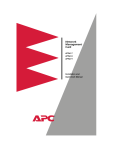






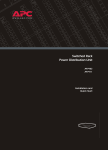
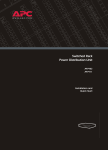
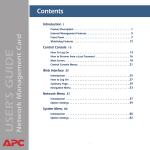

![[第1版][第2版][第3版]](http://vs1.manualzilla.com/store/data/006595470_3-dbe64e74ccb5b6ddca2b99bd6e407bf4-150x150.png)

